In today’s era of rapid urbanization and rising pollution levels, air quality has become a significant public health concern. Whether it’s for personal health, industrial compliance, smart cities, or environmental research, accurate air quality data is essential. And at the core of this accuracy lies a critical but often overlooked process: sensor calibration.
This blog dives deep into what sensor calibration is, why it’s necessary, and how it significantly impacts air quality monitoring systems.
What is Sensor Calibration?
Sensor calibration is the process of adjusting and fine-tuning a sensor’s output so that it matches a known and accurate reference or standard. Every sensor in an air quality monitoring system is designed to detect specific air pollutants like particulate matter (PM2.5, PM10), gases like carbon dioxide (CO₂), nitrogen dioxide (NO₂), volatile organic compounds (VOCs), ozone (O₃), and more.
However, these sensors don’t always output precise measurements by default. Over time, due to aging, environmental changes, or component wear and tear, their readings can drift. Calibration helps realign their measurements with certified reference instruments or known standard values, ensuring continued accuracy.
Types of Sensor Calibration in Air Quality Monitoring
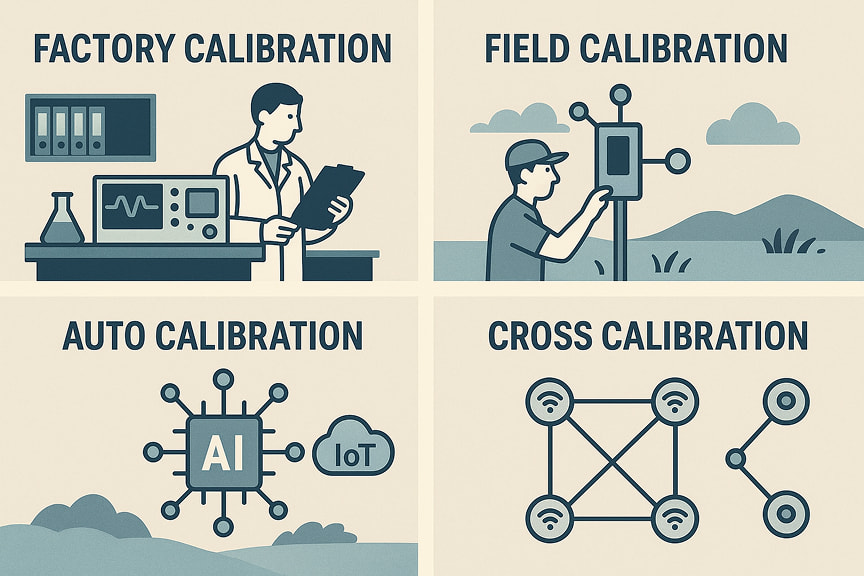
Calibration isn’t a single-step or one-time process. Depending on the application, sensor type, and environmental factors, different calibration methods are used.
1. Factory Calibration
The sensor manufacturer performs factory calibration before the product is shipped to the customer. The sensors are tested under controlled lab conditions using certified reference gases or particles. This process sets a baseline performance standard for the sensor.
Pros:
- Ensures the sensor is accurate when delivered
- Ideal for plug-and-play use
Limitations:
- May not account for real-world conditions like extreme humidity, temperature variations, or local pollutants
- Calibration can degrade over time during actual use
2. Field Calibration
Field calibration is done after deployment, in the actual environment where the sensor operates. It involves comparing the sensor’s data with that from a high-accuracy reference monitor co-located in the same setting.
Why it’s important:
- Real-world factors such as temperature, humidity, altitude, and local air composition can affect sensor performance
- Field calibration adjusts for these variables, making the readings more reliable in the actual usage location
3. Automatic or Software-Based Calibration
Modern IoT air quality monitors sometimes come with self-calibration capabilities. These devices use machine learning algorithms or cloud-based reference datasets to recalibrate themselves over time.
Advantages:
- Reduces manual calibration effort
- Ensures ongoing accuracy in dynamic environments
- Ideal for scalable sensor networks
Caveat:
- Requires robust backend systems and well-trained models to work reliably
4. Cross-Sensor Calibration
This involves calibrating lower-cost or less sensitive sensors against a highly accurate, co-located reference-grade monitor within a sensor network. It’s widely used in smart cities, environmental research, or community air quality initiatives.
Use case:
- When deploying hundreds of affordable monitors, cross-calibrating with one high-quality reference unit brings consistency across the network
Why is Sensor Calibration Important for Air Quality Monitors?
Here’s a detailed breakdown of why calibration is not just helpful, but essential.
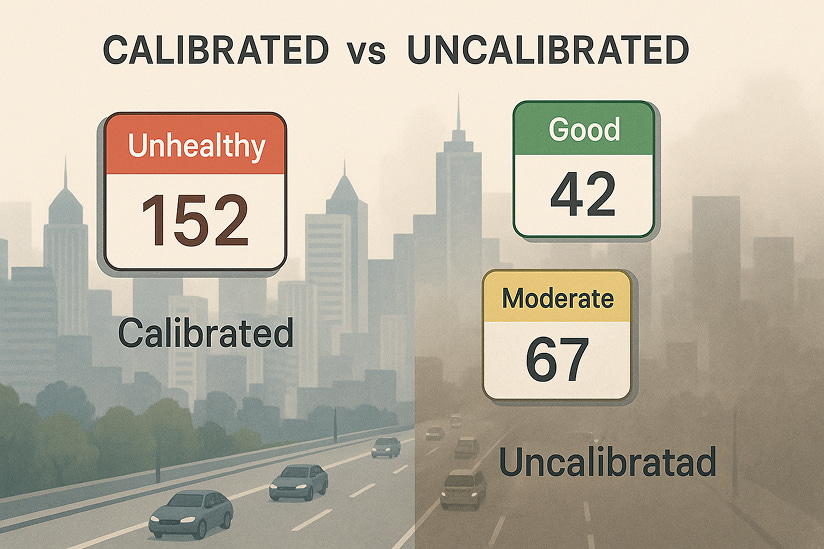
1. Ensures Accurate Data
Without proper calibration, sensors can display highly misleading readings. For example, a low-cost PM2.5 sensor could register an air quality index (AQI) of 50 (which is considered “Good”) when the actual level is 150 (“Unhealthy”).
Consequences of inaccurate data:
- People may unknowingly expose themselves to harmful air.
- Businesses may take unnecessary or ineffective mitigation actions.
- Scientific research using such data could be flawed.
Accurate data builds confidence in the system and allows for informed decision-making.
2. Builds Trust and Regulatory Compliance
In many industries and smart cities, air quality monitoring is part of regulatory compliance. Government bodies like the CPCB (India), the EPA (US), or the WHO have established air quality standards.
Calibration ensures:
- Compliance with legal standards
- Transparent and trustworthy reporting
- Accurate alerts during pollution spikes
- Data credibility for health advisories and policy changes
A non-calibrated monitor could lead to fines, public backlash, or failure in environmental audits.
3. Improves Long-Term Stability
All electronic components degrade over time. Factors like:
- Dust accumulation
- Temperature cycles
- Humidity exposure
- UV radiation
- Sensor aging
Can cause readings to deviate from actual values.
Periodic calibration:
- Corrects for sensor drift
- Maintains device reliability throughout its life cycle
- Helps avoid premature replacement of devices
It is essentially like routine servicing for your air quality monitoring system.
4. Crucial for Data Analytics and Smart Systems
Data from air quality monitors is often fed into:
- Air quality forecasting models
- HVAC automation systems
- Pollution heatmaps
- AI-driven insights for environmental planning
These applications depend heavily on the quality of input data. If the sensors are uncalibrated, it leads to:
- Inaccurate predictions
- Poor automated decisions (like unnecessary HVAC activation)
- Misleading visualizations or alerts
Sensor calibration guarantees that all derived analytics are based on truth, not noise.
5. Enables Standardization Across Networks
Let’s say a city deploys 100 air quality sensors. Without calibration:
- Sensor A might read 60 AQI while Sensor B reads 100 in the same air conditions.
- This creates confusion and destroys the integrity of the entire network.
Calibration ensures that all sensors in a distributed network speak the same language. This uniformity is essential for comparing, averaging, and responding to pollution levels across different zones.
How is Sensor Calibration Done?
Here’s a simplified look at the typical calibration process:
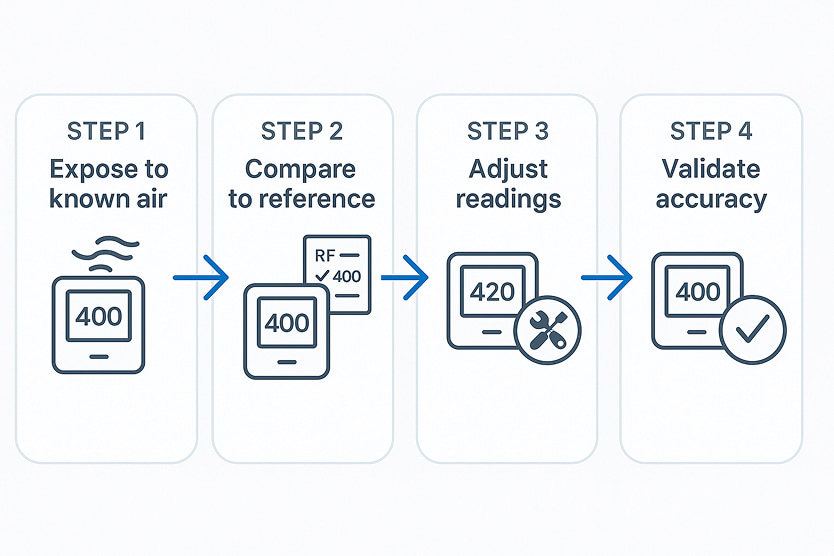
Step 1: Baseline Measurement
The sensor is placed in a controlled environment or exposed to air with a known pollutant concentration.
Example:
- For PM sensors: exposed to air with 100 µg/m³ of PM2.5.
- For CO₂: use a chamber with exactly 1000 ppm.
Step 2: Compare with Reference
Simultaneously, a reference-grade instrument (like BAM, FEM, or chemiluminescence analyzers) also measures the same air.
Step 3: Adjust Sensor Output
The readings from the sensor are adjusted (via firmware or software) so they align with the reference instrument. This may involve:
- Applying correction factors
- Tuning sensor coefficients
- Using machine learning regression models
Step 4: Validation
Post-adjustment, the sensor is tested again to confirm that:
- Readings now fall within accepted error margins (usually ±5% to ±10%)
- The device consistently reproduces accurate results
What Happens If You Don’t Calibrate?
Here’s a table summarizing potential risks:
| Problem | Consequence |
|---|---|
| Sensor Drift | Incorrect AQI levels |
| Over-Reporting | Panic or unnecessary action |
| Under-Reporting | Exposure to health risks |
| Regulation Violation | Fines or loss of trust |
| Data Inconsistency | Useless for analytics or comparisons |
Uncalibrated sensors are like compasses that point in the wrong direction—they may look fine, but they take you nowhere useful.
Real-World Example: Prana Air Monitors
At Prana Air, we prioritize calibration at every stage:
- Factory Calibration: All sensors undergo multi-point calibration before shipment.
- Environmental Compensation: We apply algorithms to adjust readings based on the parameters.
- Field Calibration: Our clients receive regular support for onsite calibration, ensuring performance in real-world scenarios.
This makes our devices trusted by:
- Government agencies
- Schools and hospitals
- Researchers and data scientists
- Smart city deployments
NEERI Study by Dr. Sunil Gulia
Prana Air PM2.5 sensor was evaluated by NEERI under Dr. Sunil Gulia’s research to identify economical and reliable air quality sensors. It ranked among the top for accuracy, stability, and cost-efficiency, making it ideal for real-world air quality monitoring in Indian conditions.
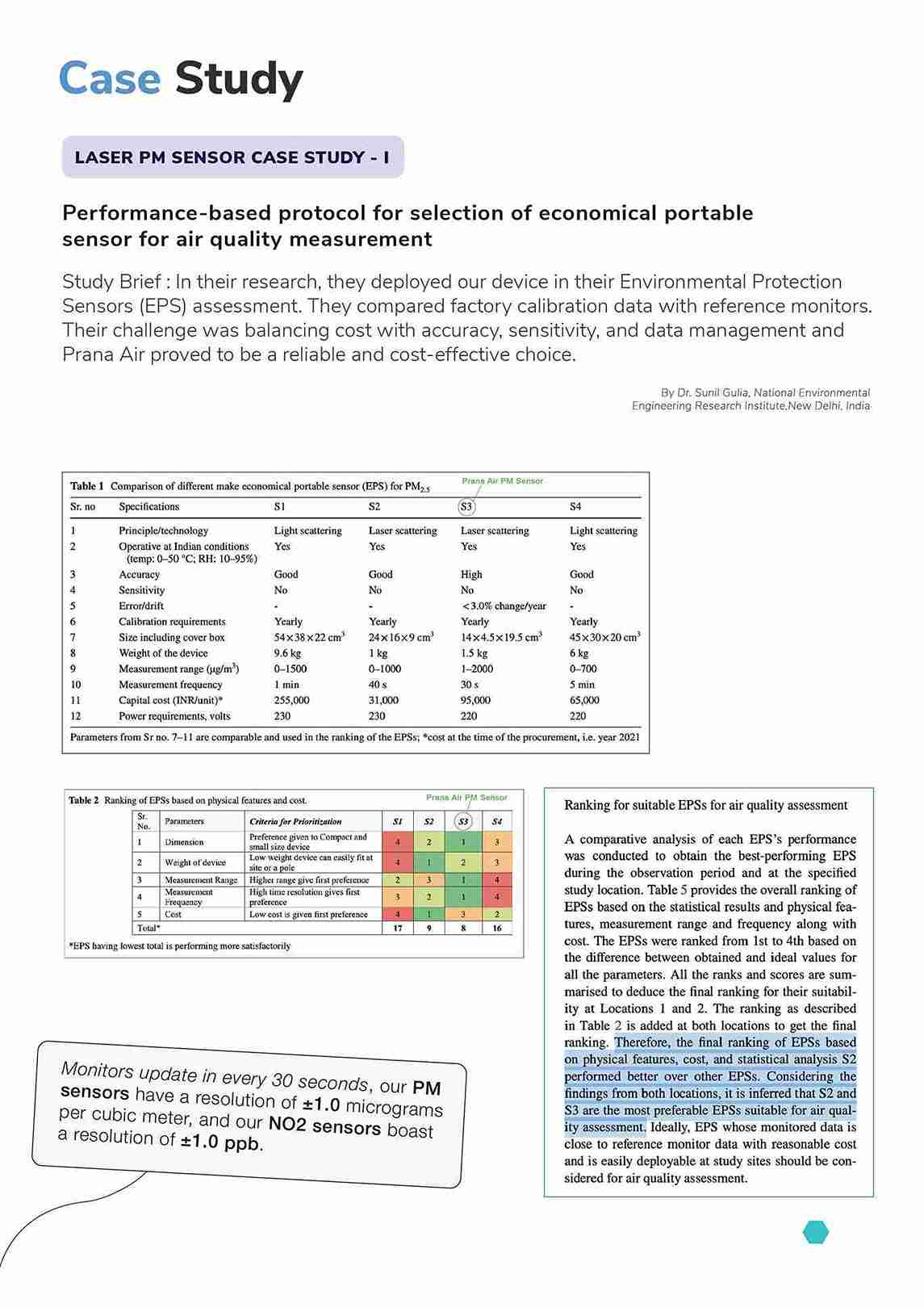
IIIT Hyderabad Study by Dr. Sachin Chaudhari
In a calibration study by IIIT Hyderabad, Dr. Sachin Chaudhari tested Prana Air’s sensor against the Aeroqual reference monitor. After calibration, it showed high correlation and accuracy, proving its value as a low-cost yet reliable sensor for PM2.5 monitoring.
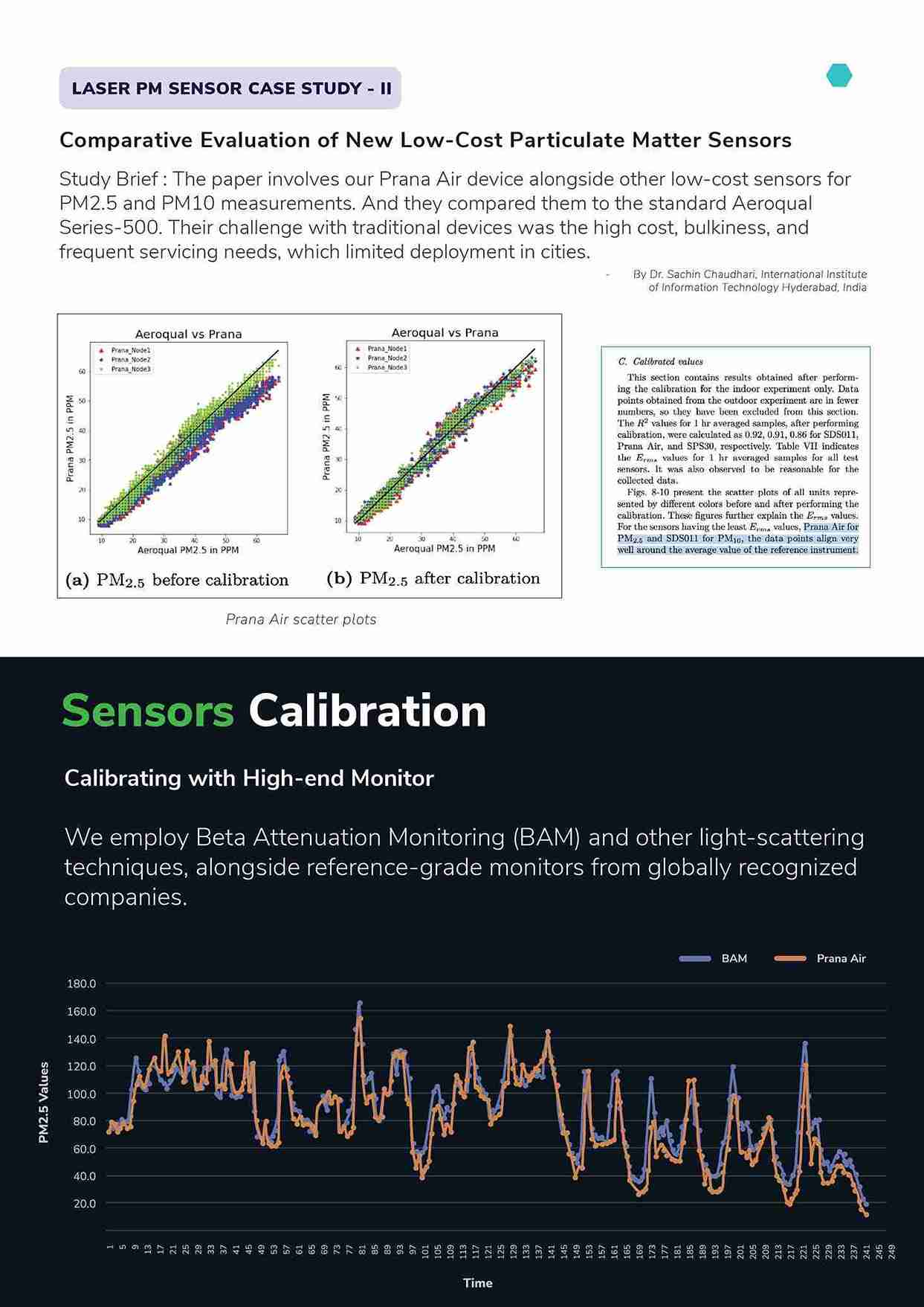
Conclusion: Calibrated Sensors = Reliable Air Quality Insights
As the world becomes more data-driven, the reliability of that data becomes critical, especially when it’s about the air we breathe.
Calibrated air quality sensors provide:
- Confidence in pollution alerts
- Compliance with standards
- Better decision-making for public health
- High-quality inputs for innovative systems
Whether you’re using a personal air quality monitor or managing a network across a city, sensor calibration is the backbone of credibility.
Need Professional Sensor Calibration Support?
If you’re using or planning to deploy air quality monitors, Prana Air offers:
- On-site calibration services
- Reference-grade co-location testing
- Software calibration via cloud integration
- Ongoing recalibration and maintenance plans
Explore more at www.pranaair.com or contact us to book a consultation.

